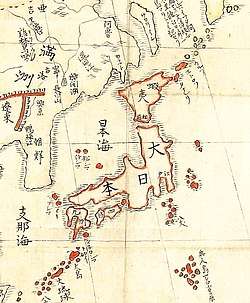Enkyō (Kamakura period)
Enkyō (延慶), also romanized as Enkei, was a Japanese era name (年号,, nengō,, lit. "year name") after Tokuji and before Ōchō. This period spanned the years from October 1308 through April 1311.[1] The reigning emperor was Hanazono-tennō (花園天皇).[2]
| History of Japan |
|---|
 |
Change of era
- 1308, also called Enkyō gannen (延慶元年): The new era name was created to mark the accession of Emperor Hanazono.[3] The previous era ended and the new one commenced in Tokuji 3.
Events of the Enkyō era
Initially, former-Emperor Fushimi administered the court up through the time he took the tonsure as a Buddhist monk,[4] which happened after this nengō ended.[5]
- 1308 (Enkyō 1): At the death of Emperor Go-Nijō, Hanazono accedes to the Chrysanthemum Throne at age 12 years; and Takaharu-shinnō, the second son of former-Emperor Go-Uda is elevated as the heir apparent under the direction of the Kamakura shogunate.[6]
- 1308 (Enkyō 1, 10th month): Kujō Moronori resigns his position as sesshō; and he is replaced in that role by Takatsukasa Fuyuhira.[7]
- 1309 (Enkyō 2, 2nd month): Konoe Iehira is elevated to the position of sadaijin.[7]
- 1310 (Enkyō 3, 11th month): The Rokuhara Tandai in Kyoto, Hōjō Sadafusa, died and Hōjō Tokiatsu was named to take his place as Kyoto representative of the military government in Kamakura.[5]
Notes
- Nussbaum, Louis-Frédéric. (2005). "Enkei" in Japan Encyclopedia, p. 179, p. 179, at Google Books; n.b., Louis-Frédéric is pseudonym of Louis-Frédéric Nussbaum, see Deutsche Nationalbibliothek Authority File.
- Titsingh, Isaac. (1834). Annales des empereurs du japon, pp. 278-279, p. 278, at Google Books; Varley, H. Paul. Jinnō Shōtōki, pp. 239-241.
- Varley, p. 240.
- Varley, p. 241.
- Titsingh, p. 279, p. 279, at Google Books.
- Titsingh, p. 278, p. 278, at Google Books; Ponsonby-Fane, Richard. (1959) The Imperial House of Japan, p. 204.
- Titsingh, p. 278, p. 278, at Google Books.
gollark: !!!
gollark: Yes, I bought mine for £80.
gollark: 500GB SSD = £55 or so.
gollark: 240GB SSD = £25 or so.
gollark: For that price you could, in today's crazy world, get (almost) 500GB of SSD storage.
References
- Nussbaum, Louis-Frédéric and Käthe Roth. (2005). Japan encyclopedia. Cambridge: Harvard University Press. ISBN 978-0-674-01753-5; OCLC 58053128
- Ponsonby-Fane, Richard Arthur Brabazon. (1959). The Imperial House of Japan. Kyoto: Ponsonby Memorial Society. OCLC 194887
- Titsingh, Isaac. (1834). Nihon Odai Ichiran; ou, Annales des empereurs du Japon. Paris: Royal Asiatic Society, Oriental Translation Fund of Great Britain and Ireland. OCLC 5850691
- Varley, H. Paul. (1980). A Chronicle of Gods and Sovereigns: Jinnō Shōtōki of Kitabatake Chikafusa. New York: Columbia University Press. ISBN 9780231049405; OCLC 6042764
External links
- National Diet Library, "The Japanese Calendar" -- historical overview plus illustrative images from library's collection
| Preceded by Tokuji |
Era or nengō Enkyō 1308–1311 |
Succeeded by Ōchō |
This article is issued from Wikipedia. The text is licensed under Creative Commons - Attribution - Sharealike. Additional terms may apply for the media files.